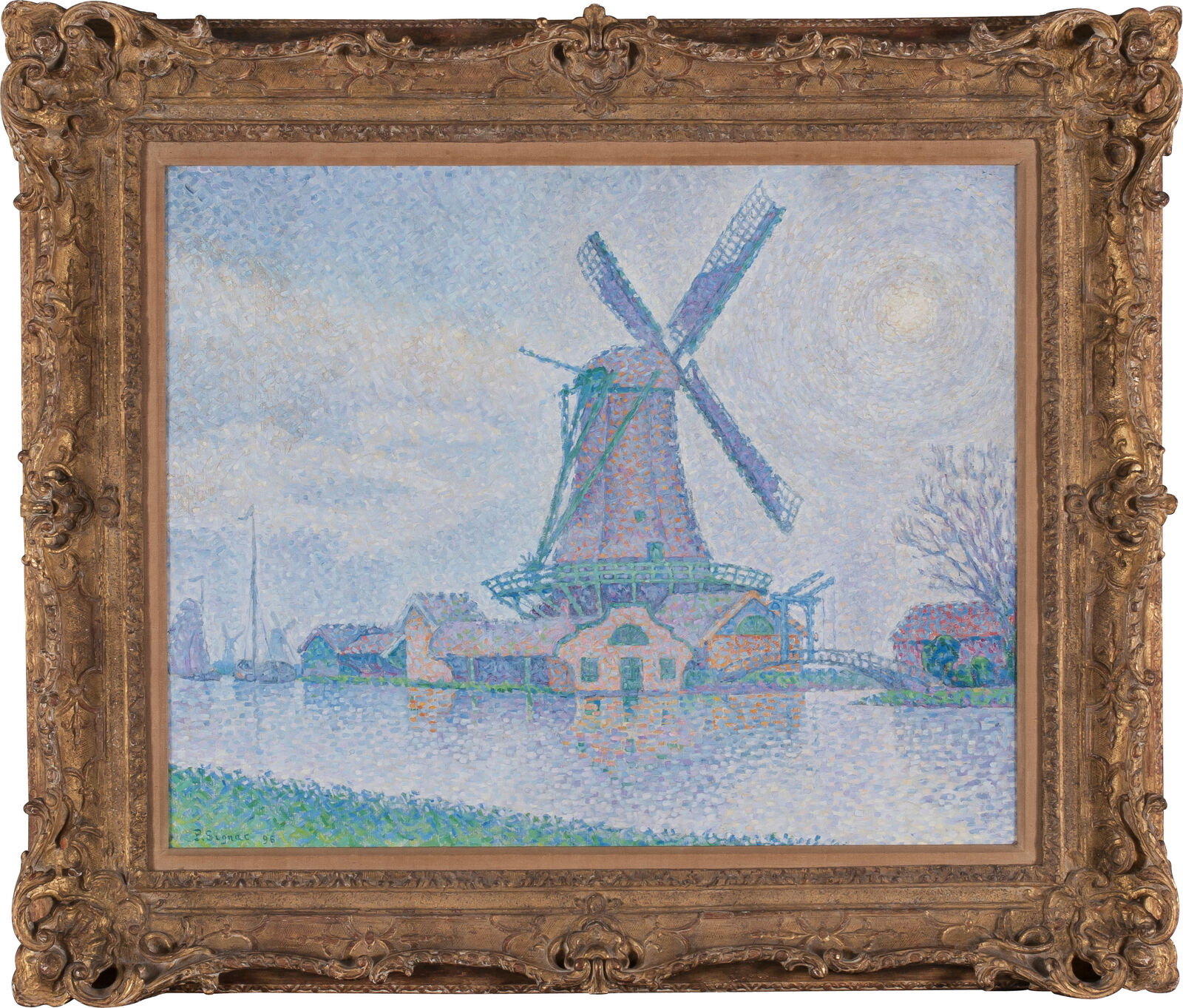Paul Signac
Mill of Edam, 1896
On view
3 further works by Signac
Copy link
Oil on canvas, 65,2 x 81,4 cm
signed and dated, lower left: P. Signac 96
Inv.-no. MB-Sig-04
Like Claude Monet, Paul Signac traveled to Holland and painted picturesque motifs there. After executing numerous watercolors in Edam on the Ijsselmeer, he painted this picture in his atelier in Saint-Tropez. Signac’s application of the paint resembles a mosaic. The brushstrokes form concentric circles around the sun, similar to lines of energy. In the grass and clouds the paint is applied in a grid formation.
In the mid-1890s, Paul Signac and Henri-Edmond Cross distanced themselves from the rigid technique of Georges Seurat that had characterized their earlier Neo-Impressionist works. Both painters increasingly perceived the strict, methodical dissection of the picture plane into tiny dots of color as too “mechanical.” Instead, they strove for a freer, more playful approach, without entirely rejecting the basic method of color division. In a diary entry of September 1895, Signac noted: “Technique is increasingly giving way to feeling. We are leaving the hard and necessary period of analysis, where all our experiments looked alike, to push forward into a phase of individual and diverse artistic creation.”
Signac painted Mill of Edam in early 1896 during a trip to the Netherlands with his friend and fellow artist Théo van Rysselberghe. The work is likely indebted to Signac’s role model Claude Monet, who had spent several months in Zaandam in 1871 and had produced numerous paintings with typical Dutch motifs. The color scheme, dominated by violet tones, is disrupted by the strip of grass in the foreground as well as by architectural elements articulated in green around the mill. The glowing yellow sphere of the sun in the upper right sets a further accent, with chromatic echoes in the sky and the water. To the right, a modern bascule bridge constructed of iron is juxtaposed with the traditional windmill; such symbols of technological progress were integrated into the landscape paintings of many other Neo-Impressionists as well.
Three years after the creation of this work Signac published his treatise Eugène Delacroix to Neo-Impressionism, distinguishing himself as the leading theorist of Pointillism. In a central passage of the book, he ambitiously defined the movement’s goals: “By the elimination of all muddy colors, by the exclusive use of optical mixture of pure colors, by a methodical divisionism and a strict observation of the scientific theory of colors, Neo-Impressionism insures a maximum of luminosity, of color intensity, and of harmony—a result that has never yet been obtained.”
In the catalogue raisonné of Signac’s paintings compiled by Françoise Cachin and Marina Ferretti-Bocquillon, Mill of Edam is listed as no. 294. Another closely related version of the motif was completed by Signac in 1898 and is listed as no. 317.
Daniel Zamani
Maîtres français, Galerie Georges Moos, Geneva, May 1946, no. 38
Impressionism: The Hasso Plattner Collection, Museum Barberini, Potsdam, from September 5, 2020
April 17, 1897, Pierre
Lagarde, Paris, purchased from the artist
March 27, 1931, Hôtel Drouot, Paris, lot 94
M. Wormser, Paris, acquired at the above sale
until at latest 1932, Gaston Lévy, Paris
May 8, 1948, Galerie Georges Moos, Geneva, lot 214
n.d., Jean Dreyfus-Graf, Switzerland
July 31, 1950, M. Knoedler, New York, acquired from the above, inv.-no.
A4410
February 21, 1951, Hugues Le Gallais, New York and Washington, D.C., acquired
from the above
March 19, 1958, Sotheby Parke Bernet, New York, lot 61
Francois L. and Meta Schwarz, New York, acquired at the above sale
November 6, 2001, Christie’s, New York, lot 37
Private collection, acquired at the above sale
n.d., Private collection, Italy, inherited from the above
February 5, 2020, Christie’s, London, lot 12, consigned by the above
Paul Signac, Cahier d'opus 1887–1902 (The artist’s list), (Le moulin d'Edam)
Paul Signac, Cahier manuscrit 1902–1909 (The artist’s list), (Le moulin d'Edam)
Gaston Lévy and Paul Signac, Pré-catalogue 1929–1932 (The artist’s catalogue), p. 294, ill. p. 294
Maîtres français, exh. cat. Galerie Georges Moos, Geneva 1946, no. 38 (Moulin à vent)
J. Focarino, Privately Owned Paintings and Drawings from the Collection of François L. Schwarz, New York 1974, p. 62, ill. p. 63 (Windmill in Holland)
Françoise Cachin and Marina Ferretti-Bocquillon, Signac: Catalogue raisonné de l'œuvre peint, Paris 2000, no. 294, p. 226, ill. p. 226
Barberini Audioguides
Do you have suggestions or questions?
sammlung@museum-barberini.de.

